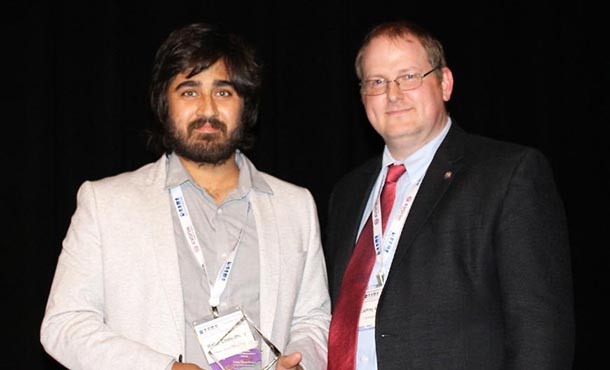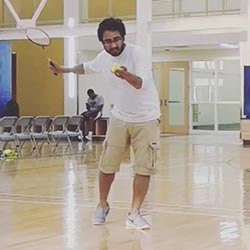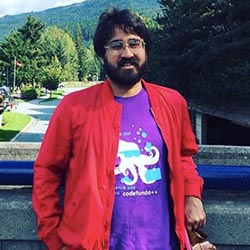
Chowdhury awarded the North American Membrane Society (NAMS) Outstanding Researcher Award in 2019 by Jeffery McCutcheon, president of the NAMS. IMAGE: RATUL CHOWDHURY
Alumni spotlight: Ratul Chowdhury
6/15/2020
By Jamie Oberdick
UNIVERSITY PARK, Pa. — After receiving his bachelor’s degree in chemical engineering at Jadavpur University in Kolkata, India, Ratul Chowdhury came to Penn State in 2013 as a doctoral student in chemical engineering. Chowdhury conducted research as a joint student in the labs of Costas Maranas, Donald B. Broughton Professor of Chemical Engineering, and Manish Kumar, formerly of Penn State and now associate professor at the University of Texas. His research focused on computational protein design and was highlighted by leading the team efforts that developed PoreDesigner, a fully automated computational workflow process for altering the pore size of a bacterial channel protein. This process enables assembly of the proteins into artificial membranes for precise sub-nanometer scale separation of solutes of marginal size difference, which can improve water purification and bioseparations. Chowdhury received 13 honors and awards as an undergraduate and doctoral student, including the 2019 American Institute of Chemical Engineering Separations Division Outstanding Graduate Fellowship, the Enzyme Engineering Conference Graduate Award, North American Membrane Society Young Scientist Award and the Best Poster and Best Paper Awards at the 2018 Penn State Chemical Engineering Graduate Symposium. He has also been published 17 times, and already holds one U.S. patent. He recently talked about his research, his new postdoctoral life at Harvard University and his Penn State memories.
What is your area of expertise?
There are approximately 20,000 proteins of varying length in the human body. Each protein molecule can be imagined as a string of amino acids which undergo a complex folding around itself to yield a three-dimensional structure. Currently, I am computationally investigating the “grammar” or “rules” that govern them — given a sequence of amino acids, what would the final folded three-dimensional structure of the protein be, within several angstroms of accuracy.
During my doctoral degree research, I developed several optimization-based tools to predict changes to a starting protein to enable us to use this protein for biochemically relevant uses. For example, we were able to successfully design a bacterial channel protein, resembling a nanoscopic hollow tube, to access sub-nanometer pore sizes. It was demonstrated to perform perfect desalination when embedded in a synthetic membrane material.
What do you like most about your research?
Protein structure prediction is important for applications ranging from green chemistry, such as biofuel production and water purification, and biopharmaceuticals, such as drug delivery, to point-of-care diagnostics, such as vaccine design, and DNA sequencing.
You recently landed a postdoctoral research role at Harvard. Talk a bit about what that is and what you will be doing in this role.
I am currently at the Laboratory of Systems Pharmacology, Harvard Medical School, as a postdoctoral fellow. My work here has two components. I am working on building better learning algorithms that represent amino acid sequence of a protein as a language, for example English, and represent the corresponding structure, sequence of angles, as another language, for example French. Then I will use a Google Translator-type algorithm to extract the grammar of translating the sequence to the structure from existing proteins. I am working on predicting accurate structures of all human ion channel proteins, which are important antiarrhythmics drug targets for heart diseases. We envision using these structures to subsequently predict new drug molecules that are functionally efficient, but are non-opioid, non-sleep-inducing.
If someone asked you how your research is helping to improve the world, what would you tell them?
The need for predicting a high-resolution molecular level picture of protein structures is a key component to design drugs against a disease-causing pathogen, such as SARS-CoV-2 for COVID-19. In this regard, we have been able to contribute in (a) identifying how and why this current strain of the virus exhibits high human infectivity even though it is quite similar to the 2002 SARS, (b) predicting an antibody molecule that could possibly prevent SARS-CoV-2 from entering human cells and (c) discerning the evolution in this virus starting from benign strains that were harbored by bats and pangolins, to a version that preferentially infects humans.
What were a few examples of value that you received from your Penn State chemical engineering education? How did it prepare you for your next step in your career at Harvard?
My experience as a joint student in the research groups of Costas Maranas and Manish Kumar has taught me strong research ethics, lateral thinking, skills to collaborate and most importantly how to provide lucid yet information-rich narratives of my work. I think this played a very big role during my interview at Harvard as the technical talk I had to give constituted a key-piece of the hiring process.
What are some things that you look back on fondly when you remember your time at Penn State?
Penn State was home for six long years since 2013, when I joined the doctoral program. I remember traveling for a conference, where I had the chance of playing table-tennis with a professor and later learned from him that he was an Olympic athlete. No wonder he won all games against me.
What is something about you that people might find surprising?
I like cartooning about the ups-and-downs of doctoral student life — which a lot of people relate to. I maintain a Reddit page of all the art I do at r/GradLifeWoes.






